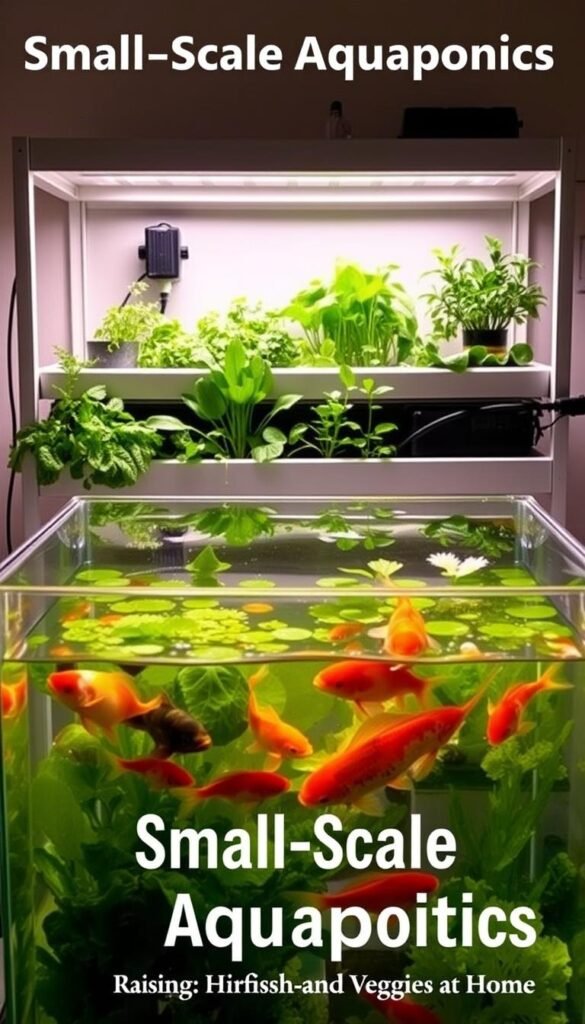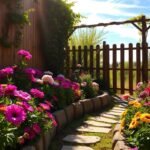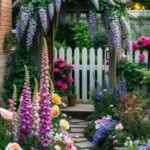Imagine harvesting fresh lettuce and herbs while your fish swim happily in a connected tank—all without soil or synthetic fertilizers. This is the magic of a closed-loop ecosystem that combines aquaculture and hydroponics. By linking a fish tank to a grow bed, you create a self-sustaining cycle where plants filter water for fish, and fish waste feeds the plants.
This method uses 90% less water than traditional gardening, making it perfect for eco-conscious households. You’ll skip chemical additives, enjoy organic produce year-round, and reduce grocery bills. Even better, it fits in small spaces like patios, garages, or sunny corners indoors.
Setting up your first aquaponics system is simpler than you think. Start with hardy fish like tilapia or goldfish and fast-growing greens like kale or basil. The setup naturally balances pH levels and nutrients, requiring minimal upkeep after the initial cycle.
Ready to turn your home into a mini-farm? In the sections ahead, we’ll break down equipment choices, maintenance tips, and troubleshooting tricks to help your system thrive. Let’s dive into the details!
Introduction to Small-Scale Aquaponics
Think of a system where fish waste becomes plant food, creating a natural loop. This innovative approach is reshaping how urban growers produce fresh food sustainably. Compact setups thrive in apartments, backyards, or classrooms—no sprawling land required.
Grow media acts as both a plant anchor and a filter. Materials like clay pebbles or lava rock house beneficial bacteria that convert fish waste into plant-ready nutrients. Pair this with quality fish food to keep your aquatic friends healthy and your greens well-fed.
A reliable water pump keeps everything flowing smoothly. It moves nutrient-rich water from the fish tank to the grow bed, ensuring roots get what they need. Without proper circulation, the ecosystem can’t balance itself.
| Component | Purpose | Pro Tip |
|---|---|---|
| Grow Media | Supports plants and bacteria | Use lightweight, pH-neutral options |
| Fish Food | Fuels the nutrient cycle | Choose high-protein pellets |
| Water Pump | Circulates resources | Opt for energy-efficient models |
You’ll need just a few basics to start: a fish tank, grow bed, and tubing. Test the water weekly, feed your fish consistently, and watch your garden flourish. Ready to join the loop?
Understanding the Basics of Aquaponics
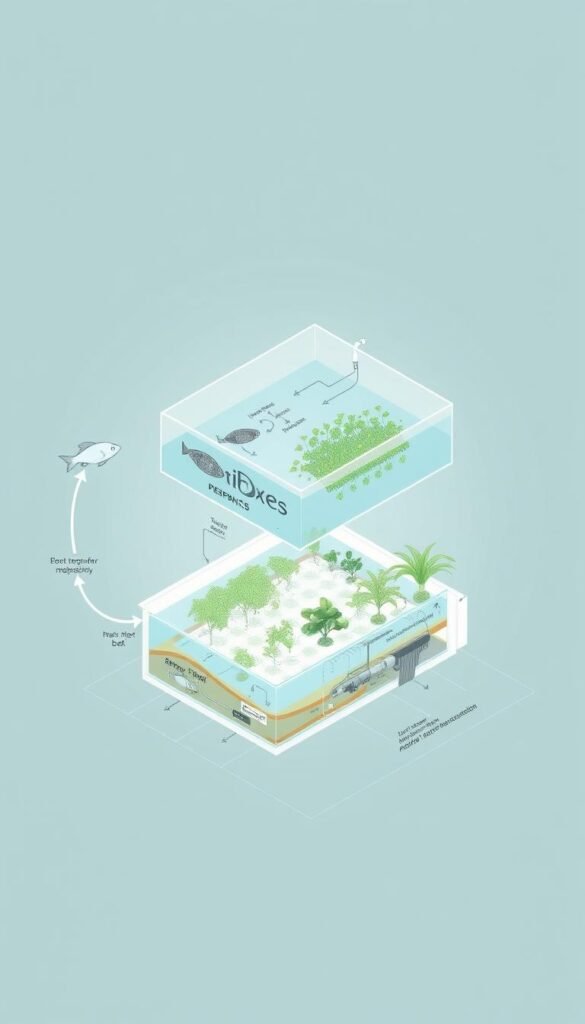
Picture a living dance between finned friends and leafy greens—no dirt, no chemicals, just pure teamwork. At its core, this method thrives on three partners: your aquatic pets, hungry plant roots, and invisible bacteria working behind the scenes. Together, they turn waste into dinner plates through nature’s own recycling program.
How Fish and Plants Work Together
Your fish produce waste rich in ammonia. Sounds gross? Not for those busy bacteria! They break it down into nitrates—a gourmet meal for greens. As plant roots soak up these nutrients, they filter the water, keeping it safe for fish to thrive. It’s like having a self-cleaning aquarium that grows salad toppings.
The Nitrogen Cycle Explained
Here’s where science meets simplicity. Ammonia from fish gets converted first to nitrites, then to nitrates. Plants grab those nitrates, purifying the water before it flows back to the tank. Test kits help track this cycle, ensuring nobody gets overwhelmed by toxins.
| Stage | Process | Key Players |
|---|---|---|
| 1. Waste Release | Fish produce ammonia | Tilapia, goldfish |
| 2. Conversion | Bacteria create nitrates | Nitrospira species |
| 3. Absorption | Plants clean water | Lettuce, basil |
Balancing this trio takes patience but pays off. One urban gardener grew 10 lbs of kale monthly while raising plump tilapia—all in a 50-gallon setup. Your turn to join the loop!
Key Components of an Aquaponics System
Just like a well-oiled machine, your setup relies on core parts working in harmony. Three elements form the backbone: the aquatic habitat, plant zones, and the hidden network that keeps everything flowing. Get these right, and you’ll create a balanced environment where life thrives effortlessly.
Fish Tanks and Grow Beds
Your aquatic friends need a sturdy home—food-grade plastic or fiberglass tanks work best. Size matters: a 50-gallon tank supports 1 lb of fish, while grow beds should be 1/3 that volume. Urban gardeners often repurpose IBC totes or stock tanks for budget-friendly solutions.
Grow beds sit above the tank, filled with clay pebbles or gravel. These media anchor plants and host beneficial bacteria. One Colorado DIYer built cascading beds from recycled pallets, tripling her herb yield without extra floor space.
Plumbing, Pumps, and Air Systems
Water movement is your system’s heartbeat. PVC pipes connect tanks to grow beds, while submersible pumps lift nutrient-rich water upward. Pro tip: Use a timer to cycle water every 15 minutes—it prevents root rot and saves energy.
Don’t skimp on aeration! Air stones oxygenate the tank, keeping fish lively. A Minnesota grower swapped noisy pumps for solar-powered models, cutting his energy bill by 40%. Remember: Clogged filters starve both plants and fish—clean intake screens weekly.
| Component | Best Materials | Common Pitfalls |
|---|---|---|
| Tank | Polyethylene | UV degradation |
| Pipes | Schedule 40 PVC | Algae buildup |
| Pump | Magnetic drive | Overheating |
Essential Equipment and Materials

Your aquaponics setup’s success hinges on three core tools: pumps that move life-giving water, media that cradles roots, and lights that mimic the sun. Let’s unpack what makes each component vital—and how to pick winners without breaking the bank.
Choosing the Right Water and Air Pumps
Water pumps act as your system’s circulatory system. For every 100 gallons of water, aim for a pump that cycles 300-500 gallons hourly. Magnetic drive models save energy and run quieter—key for indoor setups. Pair it with an air pump to oxygenate the tank; fish need 5-8 ppm dissolved oxygen to thrive.
| Pump Type | Best For | User Tip |
|---|---|---|
| Submersible | Small systems | Clean intake monthly |
| Inline | Large setups | Use pre-filters |
| Solar-Powered | Off-grid use | Add battery backup |
Selecting Grow Media and Lighting
Clay pebbles lead the pack for grow media—they’re pH-neutral and resist compaction. Avoid gravel if you hate scrubbing mineral deposits. For lighting, full-spectrum LEDs outshine fluorescents by lasting 50% longer while using 40% less energy. Position lights 12-18 inches above plants for leafy greens; fruiting varieties need brighter setups.
- Test media buoyancy: Good options sink when saturated
- Use timers for lights—14-16 hours daily mimics summer sun
- Rotate plants weekly for even light exposure
One Arizona grower doubled her basil yield by switching to expanded shale media and adjustable LED bars. Smart choices here mean happier plants and fewer headaches down the line.
How Aquaponics Works: Natural Nutrient Cycling
Nature’s ultimate recycling program lives in your backyard—or kitchen corner. Here’s how it works: Fish release waste packed with ammonia, which would poison them in stagnant water. But in your closed-loop system, beneficial bacteria jump into action. They transform that ammonia first into nitrites, then into nitrates—plant superfood!
These nitrates flow straight to your grow bed, where hungry roots snatch them up. As plants feast, they scrub the water clean before it returns to the fish. One urban gardener grew 15 tomato plants this way, using just three goldfish to fuel the cycle!
Different systems handle this dance uniquely. Media beds use clay pebbles to anchor plants and host bacteria. Raft setups let roots dangle directly in nutrient-rich water. Hybrid models combine both approaches for maximum efficiency.
| Stage | Process | Speed |
|---|---|---|
| Ammonia Conversion | Bacteria break down waste | 2-6 weeks |
| Nitrate Delivery | Water pumps to plants | Continuous |
| Water Purification | Roots filter toxins | 24/7 |
Keep your loop thriving with weekly water tests. If nitrate levels dip below 5 ppm, add more fish or reduce plant count. A balanced system grows plump peppers and happy fish side by side—no chemicals needed!
One secret? The grow bed depth matters. Shallow beds (6-8 inches) work best for herbs, while deeper setups (12 inches) support fruiting plants. Adjust your system’s flow rate to match—your greens will thank you with bumper harvests!
Designing Your Aquaponics Setup for Home
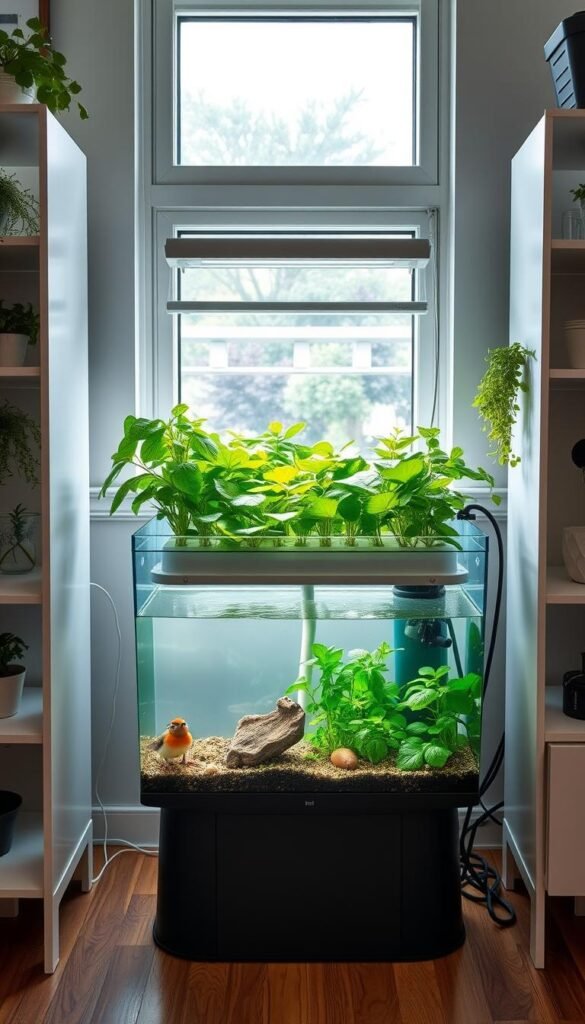
Positioning your system is like solving a puzzle—every piece needs to fit just right. Start by scouting spots with 6-8 hours of daily natural light, preferably near south-facing windows. No sunny nook? No problem. Modern LED grow lights can mimic sunlight’s full spectrum for leafy greens and herbs.
Location and Lighting Considerations
Balance is key. Too much direct sun overheats fish tanks, while dim corners stunt plant growth. Use a light meter app to measure intensity—aim for 2000-3000 lux for herbs, 5000+ for fruiting crops. Basements and garages work if you add supplemental lighting and climate control.
Environmental and Space Requirements
Your setup needs stable temps (65-75°F) and good air flow. Avoid drafty areas near doors or vents. Leave 18 inches around the system for maintenance access. Elevate tanks slightly to prevent tripping hazards and simplify water testing.
Arrange components vertically if floor space is tight. Stackable grow beds above fish tanks save square footage while boosting visual appeal. One apartment gardener built a sleek wall-mounted unit that produces basil and cherry tomatoes year-round!
For deeper insights on balancing aquaponic gardening basics, explore our detailed guide. Remember: A well-planned system becomes a living centerpiece that feeds both body and soul.
Selecting the Ideal Fish for Your System
Choosing the right fish is like picking teammates for a relay race—each needs to thrive in your specific environment. Start with species that handle water fluctuations and crowded spaces. Your location’s climate plays a big role: tropical fish like tilapia need warmer temps (75-85°F), while goldfish tolerate cooler ranges (65-72°F).
Plastic tanks work well but retain heat—shade them in sunny areas. For every 10 gallons of water, stock 1-2 small fish initially. Overcrowding stresses them and clogs filters. Watch for rapid gill movement or surface skimming—signs they need more oxygen or space.
| Species | Temp Range | Stocking Density | Best For |
|---|---|---|---|
| Tilapia | 75-85°F | 1 lb per 5 gal | Warm climates |
| Goldfish | 65-72°F | 1 per 10 gal | Beginners |
| Catfish | 70-80°F | 1 per 8 gal | Fast growth |
| Koi | 59-77°F | 1 per 15 gal | Outdoor setups |
Adjust fish numbers as your system matures. A 50-gallon tank in Arizona might hold 8 tilapia, while a Maine setup with goldfish could support 5. Test water weekly—ammonia spikes mean you’ve added too many fish too soon.
Pro tip: Introduce juveniles first. They adapt better than adults and give you time to perfect your balancing act. Happy fish mean vibrant plants—and a thriving closed-loop garden!
Picking the Best Plants for Growth
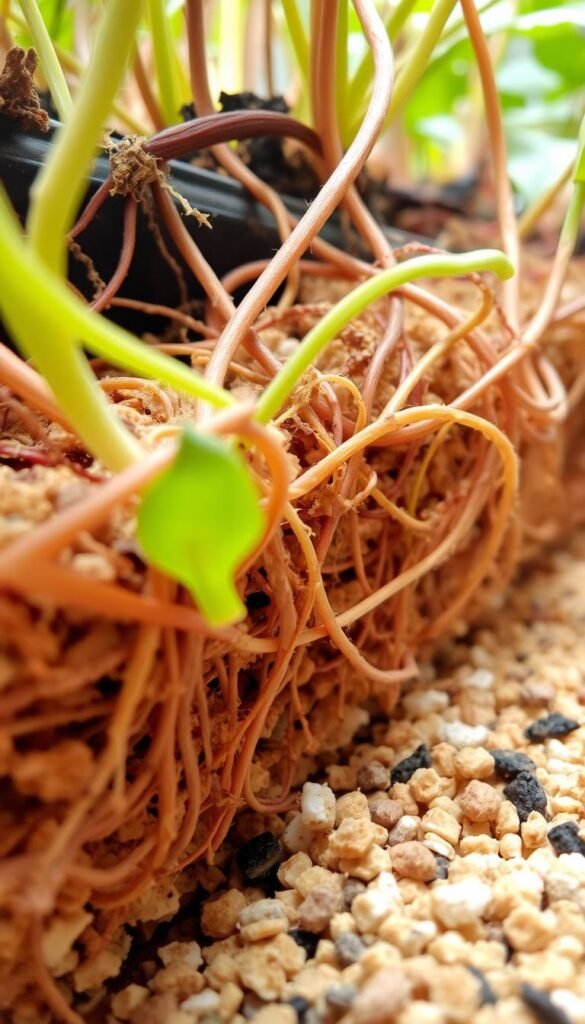
Your green thumb meets nature’s filtration system in this perfect pairing. Leafy greens like spinach and arugula excel here—their roots adapt quickly to water-based environments while efficiently absorbing nutrients. Start with these forgiving varieties before tackling tomatoes or peppers.
The media in your grow bed does double duty. It anchors plants and houses bacteria that convert fish waste into plant food. Clay pebbles work best, allowing roots to breathe while trapping ammonia for processing. Avoid dense materials like sand—they suffocate root zones.
Balance is key. Too many plants can’t process all the ammonia, while too few leave nutrients unused. One Maryland grower found success pairing 12 kale plants with 5 goldfish in a 40-gallon system. Test nitrate levels weekly—they should stay between 5-50 ppm.
| Plant Type | Root Depth | Media Preference |
|---|---|---|
| Leafy Greens | Shallow (4-6″) | Clay pebbles |
| Herbs | Medium (6-8″) | Lava rock |
| Fruiting Plants | Deep (12″+) | Gravel mix |
Basil and mint thrive in these systems, their roots spreading wide to filter water effectively. As your confidence grows, try strawberries—their trailing roots love cascading through media beds. Remember: Happy plants mean cleaner water for your aquatic partners!
Small-Scale Aquaponics: Raising Fish and Veggies at Home
Kick off your sustainable garden with strategies that balance simplicity and science. Start by testing water weekly—ideal nutrient levels keep plants thriving and fish stress-free. A $15 test kit tracks ammonia, nitrates, and pH, helping you spot imbalances before they escalate.
Building Your Ecosystem Foundation
Boost bacteria colonies by adding porous surfaces like lava rock to grow beds. These microbes break down fish waste into plant-ready food. For faster results, rub a handful of established media from a friend’s system onto yours—it jumpstarts the nitrogen cycle.
Keep the top third of your grow bed dry to prevent algae growth. This space also makes harvesting herbs easier. One Ohio gardener uses removable trays in her setup, swapping out mature greens without disturbing roots below.
| Strategy | Beginner Benefit | Pro Tip |
|---|---|---|
| Partial Water Changes | Prevents toxin buildup | Replace 10% weekly |
| Dual Thermometers | Tracks tank/grow bed temps | Keep within 5°F difference |
| Pre-Cycled Media | Speeds bacteria growth | Ask local farms |
Start small—a 20-gallon tank with 3 goldfish supports 6 lettuce plants. Expand gradually as your confidence grows. Remember: Overfeeding fish clouds water and overloads nutrient levels. Feed sparingly, and let your plants handle the rest!
Step-by-Step Guide to Setting Up Your System
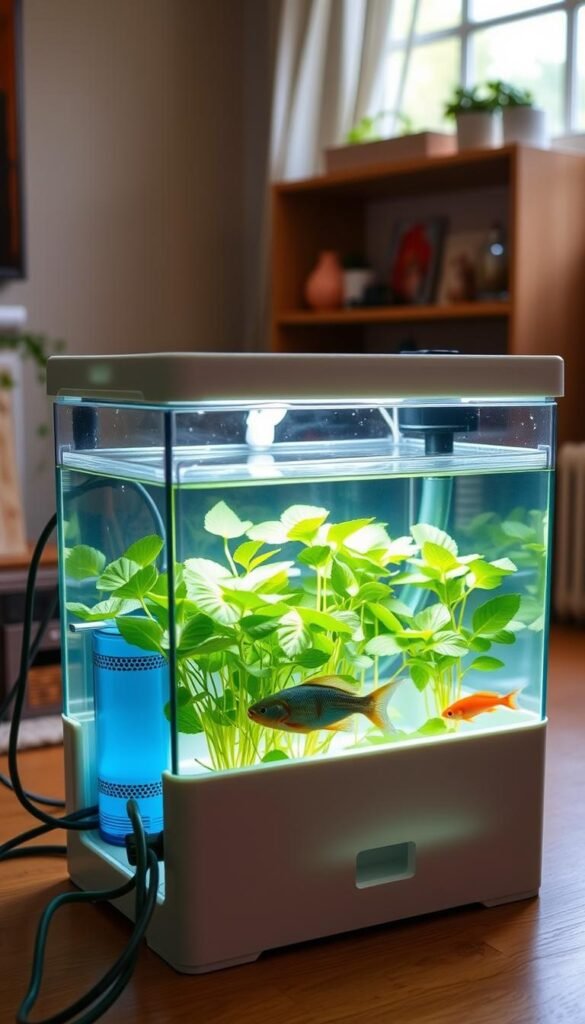
Transform your space into a thriving ecosystem with these foolproof setup steps. Begin by placing your fish tank on a level surface that can handle its weight when full—garage floors or reinforced shelves work best. Keep it away from direct sunlight to prevent algae blooms and temperature swings.
Position the grow bed 12-18 inches above the tank using cinder blocks or metal stands. This height lets gravity return filtered water smoothly. Connect the water pump to PVC pipes, ensuring joints are sealed tightly with aquarium-safe silicone.
- Assemble core parts: Attach the pump to the tank’s bottom, routing tubing upward
- Prep the grow bed: Fill it with rinsed clay pebbles, leaving 1″ space at the top
- Cycle the system: Run water for 48 hours without fish to check leaks
| Step | Key Action | Pro Tip |
|---|---|---|
| 1. Tank Setup | Secure lid & heater | Use foam padding to reduce vibrations |
| 2. Plumbing Test | Check flow rate | Adjust valve to 1-2 gallons/minute |
| 3. Waste Prep | Add starter bacteria | Use bottled nitrifying cultures |
Introduce fish after nitrate levels hit 5 ppm—this means your waste processors are active. Start with just 2-3 small fish to avoid overwhelming the system. Plant seedlings in net pots, gently spreading roots through the media.
Finally, plug in the air pump and celebrate! Your home ecosystem is now alive, turning fish waste into garden gold. Check connections daily for the first week, then settle into a rhythm of feeding and harvesting.
Maintaining Water Quality and System Health
Think of your setup as a living body—its vitality depends on clean “blood” flowing through well-maintained veins. Regular checkups prevent emergencies and keep your plants and fish thriving. Let’s break down the three pillars of system health: balanced chemistry, smooth plumbing, and smart lighting.
Monitoring pH, Ammonia, and Nutrient Levels
Test water weekly using strips or digital meters. Ideal pH stays between 6.8-7.2—too acidic? Add crushed coral. Too alkaline? Driftwood naturally lowers it. Ammonia spikes above 0.5 ppm? Cut back feeding and check pump flow.
Nutrients tell a story. Nitrates below 5 ppm mean plants are hungry—add more greens. Over 50 ppm? Time to expand your garden. A Florida grower fixed yellowing basil by adjusting iron levels through chelated supplements.
- Test at the same time daily for consistency
- Record results in a logbook or app
- Replace 10% water weekly to dilute toxins
Your plumbing acts like arteries—clogs starve the system. Flush pipes monthly with vinegar to dissolve mineral buildup. Check connections for leaks during tests. One Colorado DIYer added a secondary filter after her pump failed, saving 20 tilapia overnight.
Lights impact more than growth—they affect water temp and algae. Use timers for 14-hour cycles. LED bars positioned 18″ above lettuce reduce heat stress. If green slime appears, shorten light exposure and scrub affected areas with a toothbrush.
| Parameter | Ideal Range | Quick Fix |
|---|---|---|
| pH | 6.8-7.2 | Baking soda (raise) / peat moss (lower) |
| Ammonia | 0-0.5 ppm | Reduce feeding, increase aeration |
| Nitrates | 5-50 ppm | Add plants or change water |
Remember: Small tweaks beat major overhauls. Spot a sudden pH drop? Test again before adjusting. Your system’s resilience will surprise you—just keep those nutrients flowing and lights glowing!
Troubleshooting Common Aquaponics Challenges
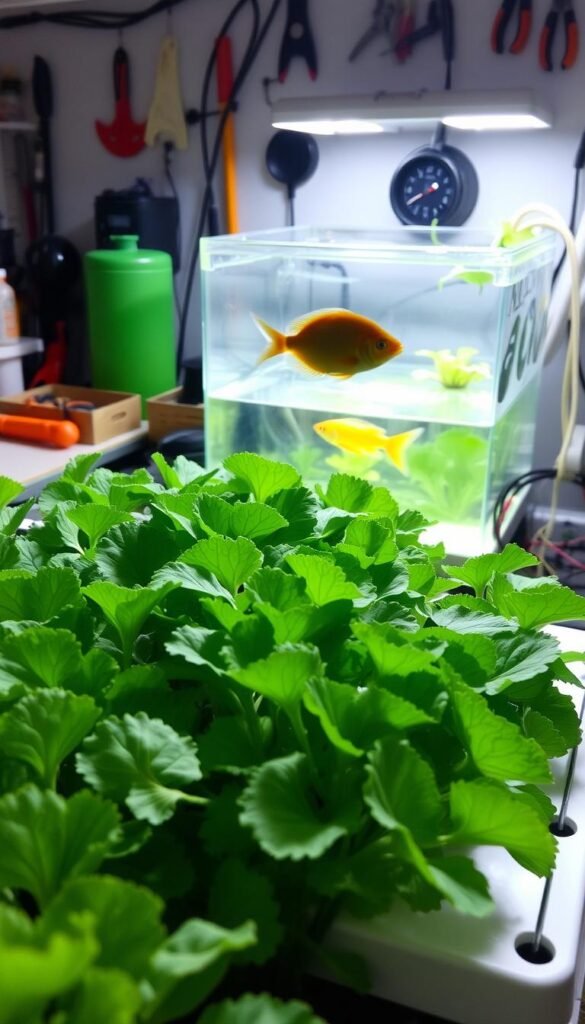
When your fish and plants aren’t thriving, it’s time to play detective. Common issues like murky water or sluggish growth often trace back to three culprits: light exposure, nutrient imbalances, or airflow gaps. Let’s crack these cases together.
Solving Algae, Pest, and Fish Health Puzzles
Green slime coating your tank? Algae love light and excess nutrients. Cover exposed holes in grow beds to block sunlight, and add floating plants like water lettuce to shade the surface. For persistent cases, reduce feeding times—uneaten feed fuels algae’s growth spurt.
Clogged bottom drains cause debris buildup. Use a turkey baster to suction gunk from tank corners weekly. One Oregon grower fixed cloudy water by adding a secondary filter mat under her grow bed—clear views returned in 48 hours!
| Issue | Root Cause | Quick Fix |
|---|---|---|
| Yellow Leaves | Low iron | Add chelated supplements |
| Gasping Fish | Low oxygen | Increase air pump power |
| Slow Growth | Clogged holes | Flush pipes with vinegar |
Pests hitchhike on new plants. Inspect leaves before adding them, and blast aphids off with water. Sticky traps near grow lights catch fungus gnats. Remember: Healthy fish rarely get sick. If they’re lethargic, test ammonia levels and adjust feed portions immediately.
Keep those holes in grow media clear—use a chopstick to poke through blockages. A balanced system rewards you with crisp greens and active fish. Now go troubleshoot like a pro!
Innovative DIY Techniques and Cost-Saving Ideas
Who says eco-friendly gardening has to break the bank? With clever hacks and everyday parts, you can build a thriving system that fits your budget. Repurpose food-grade barrels or IBC totes as fish tanks—they’re durable, lightweight, and cost a fraction of store-bought options.
Need grow beds? Old bathtubs or plastic storage bins work perfectly. Drill drainage holes, add clay pebbles, and you’re set. For plumbing, use PVC pipes from hardware stores—they’re cheaper than specialized tubing and easy to cut. One Texas family built a 50-gallon setup using only $120 worth of materials!
| Material | Source | Cost Savings |
|---|---|---|
| IBC Totes | Local farms | 70% vs new tanks |
| PVC Pipes | Hardware stores | $0.50/foot |
| Clay Pebbles | Landscaping suppliers | Bulk discounts |
Scale smartly by matching fish numbers to your tank’s gallon capacity. A 20-gallon system supports 2-3 goldfish and 8 lettuce plants. Add a $15 air pump from pet stores—it keeps water oxygenated without draining your wallet.
At the end of the day, success lies in simplicity. Check out affordable hydroponic setups for more inspiration. Use zip ties instead of clamps, and seal joints with aquarium-safe silicone. These tweaks save cash while keeping your system leak-free and efficient.
Incorporating Educational Projects into Your Setup
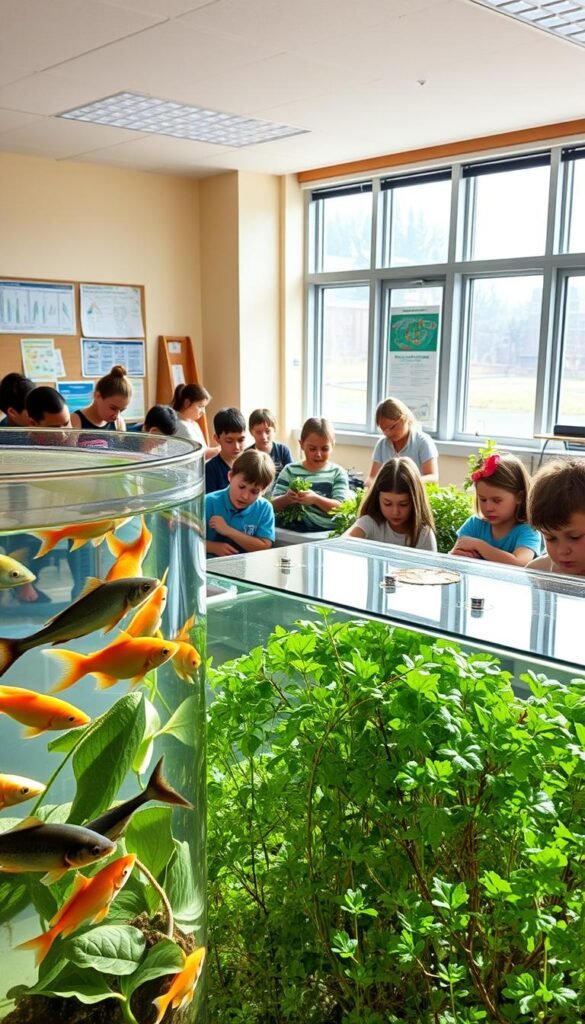
Turn your living room into a science lab where dinner grows alongside life lessons. Families can explore biology, chemistry, and sustainability through interactive projects that make learning deliciously tangible. These activities transform daily system checks into “lab time”—no textbooks required!
Hands-On Activities for Kids and Families
Track how water flows between tanks and plants using food coloring. Add a drop to the fish tank and watch it travel through pipes—a vivid way to visualize nutrient delivery. Kids love timing how long it takes for the color to reach the grow bed!
Create a day-by-day journal to document plant growth and fish behavior. Measure leafy greens weekly with rulers, and sketch fish patterns. This builds observation skills while teaching ecosystem interdependence. One Ohio family discovered their goldfish swim faster after feeding—now a favorite dinner table topic.
| Activity | Learning Focus | Pro Tip |
|---|---|---|
| Water Flow Mapping | Hydrology basics | Use washable markers on clear tubing |
| Nitrate Testing | Chemistry in action | Compare tank vs. grow bed water |
| Fish Feeding Races | Animal behavior | Time how quickly food disappears |
Host a “flow challenge” by adjusting pump speeds. Let kids predict how changes affect plant hydration and tank levels. They’ll grasp engineering concepts while keeping fish happy. Always supervise near tanks, and use battery-operated pumps for safer experiments.
End each day with a tasting party—harvest herbs for homemade pesto or mint tea. When children grow their snacks, sustainability becomes second nature. Who knew science could taste this good?
Exploring Different Aquaponics System Types
Not all closed-loop ecosystems are created equal—discover which design fits your space and goals. Four main setups dominate home gardens, each with unique strengths. Let’s break down how they work and where they shine.
Media-Based Systems
These use clay pebbles or gravel to anchor plants and filter water. Ideal for beginners, they handle varied sizes—from countertop herb gardens to garage-sized setups. Sponges in the plumbing catch debris, reducing pump clogs. One Utah grower built a 100-gallon system using repurposed wine barrels and a $40 water pump.
Raft (Deep Water Culture) Systems
Plants float on foam boards with roots dangling in nutrient-rich water. Perfect for leafy greens, these require pumps with gentle flow rates. They excel in small spaces but need precise pH monitoring. A Florida school uses raft beds to teach kids hydroponics basics.
Nutrient Film Technique (NFT)
Thin water streams flow through sloped channels, oxygenating roots. Compact and efficient, NFT uses sponges to stabilize seedlings. Best for herbs and strawberries, these systems demand reliable pumps—power outages can dry roots fast.
Hybrid Systems
Combine media beds with raft zones for maximum flexibility. A Michigan family merged both to grow tomatoes and lettuce in their 150-gallon setup. Their dual pumps handle different flow needs, while sponges in the filter box prevent clogs.
| Type | Best For | Pump Needs | Size Flexibility |
|---|---|---|---|
| Media-Based | Root vegetables | Medium power | High |
| Raft | Leafy greens | Low power | Moderate |
| NFT | Herbs | High reliability | Low |
| Hybrid | Mixed crops | Multiple pumps | Custom |
Choose based on your size limits and crop preferences. Raft systems cost less upfront, while hybrids offer long-term versatility. Remember: Sponges and pumps make or break any setup—invest in quality parts tailored to your chosen design.
Final Thoughts on Your Aquaponics Journey
Watching your home ecosystem flourish is a testament to nature’s ingenuity—and your dedication. Through weeks of careful adjustments, you’ve learned that success grows with time. Like tending an aquarium, consistent checks and balanced feedings keep your watery world thriving.
Patience becomes your ally here. Track progress over time, noting how fish activity shifts with daylight or new plants affect water clarity. Every harvest and feeding routine deepens your connection to this living cycle.
Embrace experimentation. Swap plant varieties, adjust pump timers, or test organic fish foods. These tweaks transform challenges into “aha!” moments—your system evolves as you do.
Celebrate milestones: that first unblemished lettuce leaf or the day nitrate levels stabilize. Your aquarium-inspired vigilance now yields meals grown with care. Remember, even experts started where you are today.
As seasons change, so will your setup. But the core lesson remains: time invested in observation pays dividends. Keep logs, share stories with fellow growers, and let curiosity guide upgrades. Your sustainable oasis is just beginning to bloom.

